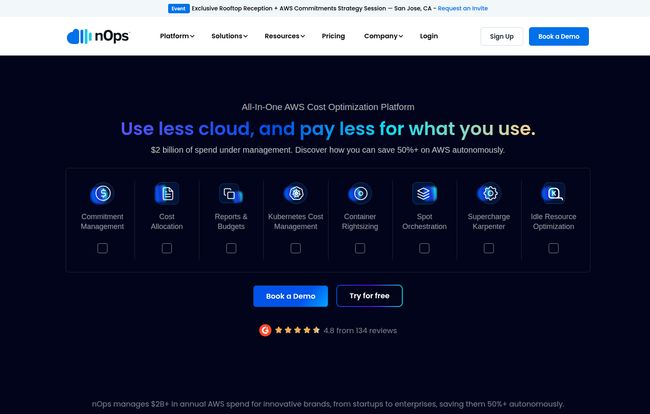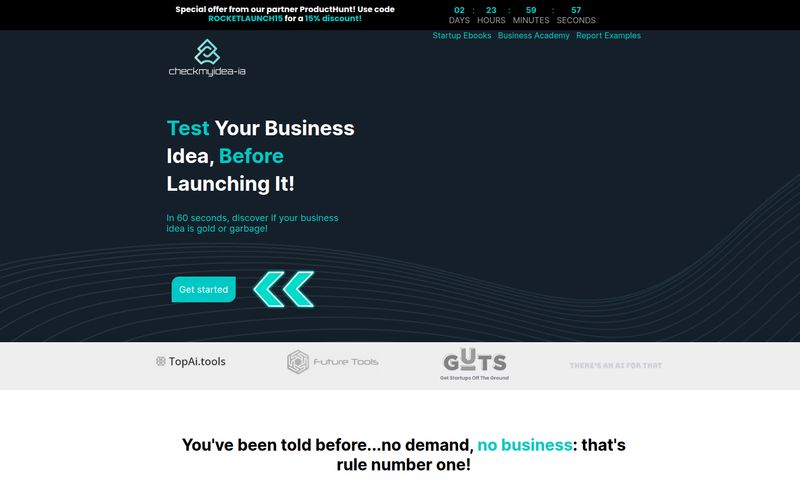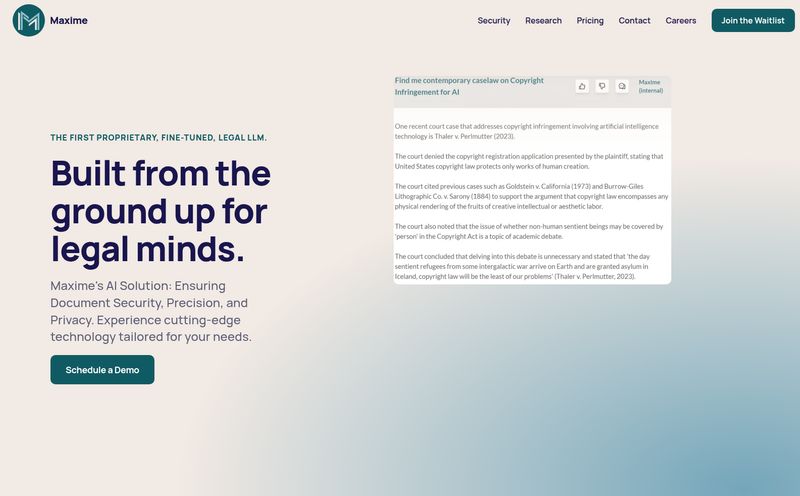That feeling when the monthly AWS bill lands? It’s a special kind of dread. A mix of “Wow, we’re really scaling!” and “Oh no, did someone leave the lights on in a server farm the size of Delaware?” For years, I’ve been in the trenches of cloud cost management, wrestling with spreadsheets, trying to manually track Reserved Instances, and basically playing whack-a-mole with unused resources. It’s a full-time job. A job nobody wants.
I’ve seen a lot of tools come and go, each promising to be the silver bullet for cloud spend. Most of them are just prettier dashboards for the same old data. So when I first heard about nOps, I was skeptical. An AI-powered platform that claims to cut AWS costs by up to 50% with zero engineering effort? Yeah, right. I’ve heard that one before.
But the numbers they were throwing around were just too big to ignore. And the more I looked into it, the more I thought… maybe, just maybe, they’re onto something here. So, I took the plunge.
What's the Big Deal with Cloud Waste, Anyway?
Before we get into nOps itself, let's talk about the monster under the bed: cloud waste. The folks at nOps claim that about 30% of all cloud spend is pure waste. And from my experience, that number feels... depressingly accurate. It's the over-provisioned instances you spun up for a test and forgot about. The Reserved Instances (RIs) you bought last year that no longer match your usage patterns. The zombie assets lurking in the dark corners of your account.
This isn't just about saving a few bucks. It's about financial discipline. It's about running a leaner, more efficient operation. In the world of FinOps, this isn't just housekeeping; it's a core business strategy.
So, What Exactly is nOps?
At its heart, nOps is a fully automated FinOps platform. Think of it less as a simple monitoring tool and more like an AI financial advisor for your entire AWS environment. It connects to your cloud accounts and uses machine learning to constantly analyze your usage, your spending, and your commitments. Its whole purpose is to find those hidden savings and—this is the important part—automatically take action on them.
This isn’t about generating a report that tells an engineer to go resize an instance. It's about the platform handling that for you. That's a huge shift from most other platforms I've used, which often just add more tasks to an already overloaded engineering team's plate.
The nOps Features That Actually Matter
A feature list is just a list. What really matters is how it solves real-world problems. Here's where I think nOps really shines.
Getting Your Commitments in Order (RIs & Savings Plans)
Managing AWS Savings Plans and RIs is a dark art. You're trying to predict future usage to get a discount, but business needs change in a heartbeat. I've seen companies lose thousands on unused commitments. nOps automates this whole circus. It analyzes your compute usage and helps you build a portfolio of commitments that actually maximizes your savings without locking you into something you won't use. It’s like having a Wall Street quant managing your cloud discounts. It’s pretty slick.
The Magic of Automation: Rightsizing and Scheduling
This is where the “no engineering effort” claim gets real. nOps identifies over-provisioned resources—those EC2 instances that are way too big for their workload—and can automatically rightsize them. Even better, it finds idle resources that are just burning cash and can schedule them to shut down during off-hours. Imagine all your dev and staging environments automatically going to sleep on weekends. The savings add up incredibly fast. It's the kind of thing you always mean to set up with scripts, but never quite get around to.

Visit nOps
A Single Pane of Glass for All Your Costs
If you're running a complex setup, you know the pain. Costs are spread across AWS, maybe some Azure or GCP, and then you've got Kubernetes throwing a whole new level of complexity into the mix. nOps pulls all of this into one place. It gives you true visibility. You can see exactly what that specific microservice in your K8s cluster is costing you and allocate those costs back to the right team. This kind of chargeback capability is gold for creating a culture of cost awareness.
The Good, The Bad, and The Billable: My Take on nOps
Alright, no tool is perfect. Let's get real about the pros and cons. The biggest pro is undeniable: it saves a serious amount of money. The promise of up to 50% savings isn't just marketing fluff; for complex, messy accounts, it's genuinely achievable. The automation is the other huge win. Taking optimization tasks off my team's hands frees them up to, you know, build products. And the visibility it provides is top-notch, especially for multi-service environments. I’ve always felt that you can't fix what you can't see, and nOps gives you a powerful set of eyes.
Now, for the other side of the coin. It's not a magic wand you just wave. There is some initial setup and configuration to get everything connected and tuned. The platform's effectiveness is also directly related to the complexity of your AWS environment. If you're running a couple of small websites on a handful of instances, it's probably overkill. But if you're managing a sprawling, dynamic infrastructure, its power grows exponentially. There can also be a bit of a learning curve to understand all the features and trust the automation. You have to be willing to let go of the reins a little, which can be tough for us control-freak engineers.
The Million-Dollar Question: What's the nOps Pricing?
This is probably my favorite part, and it's a genius business model. You won't find a standard pricing page on their site with tiered monthly fees. Why? Because nOps charges you based on a fraction of the savings they generate for you.
Let that sink in. They only make money if you save money. Their incentives are completely aligned with yours. This is such a refreshing change from the usual SaaS model where you pay a flat fee whether the tool provides value or not. With nOps, they have to prove their worth every single month. It’s a bold move that shows a ton of confidence in their product. Honestly, I wish more companies operated this way.
Is nOps the Right Tool for Your Team?
So, who is this for? If you're a CTO, a DevOps lead, or a FinOps manager at a startup or enterprise and you look at your AWS bill with a sense of dread, then yes. You should absolutely book a demo. If your engineers are spending more time on cost-cutting tasks than on innovation, you need to look at this. If you’re struggling to manage Savings Plans or get a clear view of your Kubernetes costs, nOps was practically built for you.
Who might not need it? If your AWS spend is small and predictable, and you can count your instances on two hands, you can probably manage with AWS's native tools for now. But for everyone else playing in the deep end of the pool, it’s a potential game-changer.
The Final Verdict
My initial skepticism about nOps has mostly melted away. It’s not just another dashboard; it’s an active, intelligent system that takes a massive, recurring headache off your plate. It turns the reactive, painful process of cost management into a proactive, automated, and dare I say, almost pleasant one. It’s one of the most compelling FinOps platforms I've seen in a long time, mostly because it delivers on its core promise: significant, automated savings without bogging down your technical teams. It lets your engineers be engineers again. And you really can't put a price on that.
Frequently Asked Questions about nOps
- How much can I realistically save with nOps?
- nOps states you can save up to 50% on your AWS bill. The actual amount will depend on your current infrastructure's complexity and how much waste is present, but significant savings are the platform's main value proposition.
- Is nOps hard to set up?
- There's an initial setup process to grant nOps the necessary permissions to analyze your environment. While there can be a learning curve to master all its features, the platform is designed to be highly automated once it's up and running.
- Does nOps only work with AWS?
- While its primary focus and automation are centered on AWS, nOps can provide cost visibility and analysis for other platforms like Azure, GCP, and Kubernetes, bringing all your cloud spend into a single view.
- How does nOps pricing work again? It sounds too good to be true.
- It's a performance-based model. nOps charges a percentage of the actual, verified savings it helps you achieve. If you don't save money, they don't get paid. This aligns their success directly with yours.
- Is nOps just for big companies?
- No, nOps serves a wide range of customers, from fast-growing startups to large enterprises. Any organization with a significant or complex AWS spend can potentially benefit.
Reference and Sources
- nOps Official Website - For product information, demos, and case studies.
- AWS Cloud Economics - For more on the principles of managing cloud spend.



